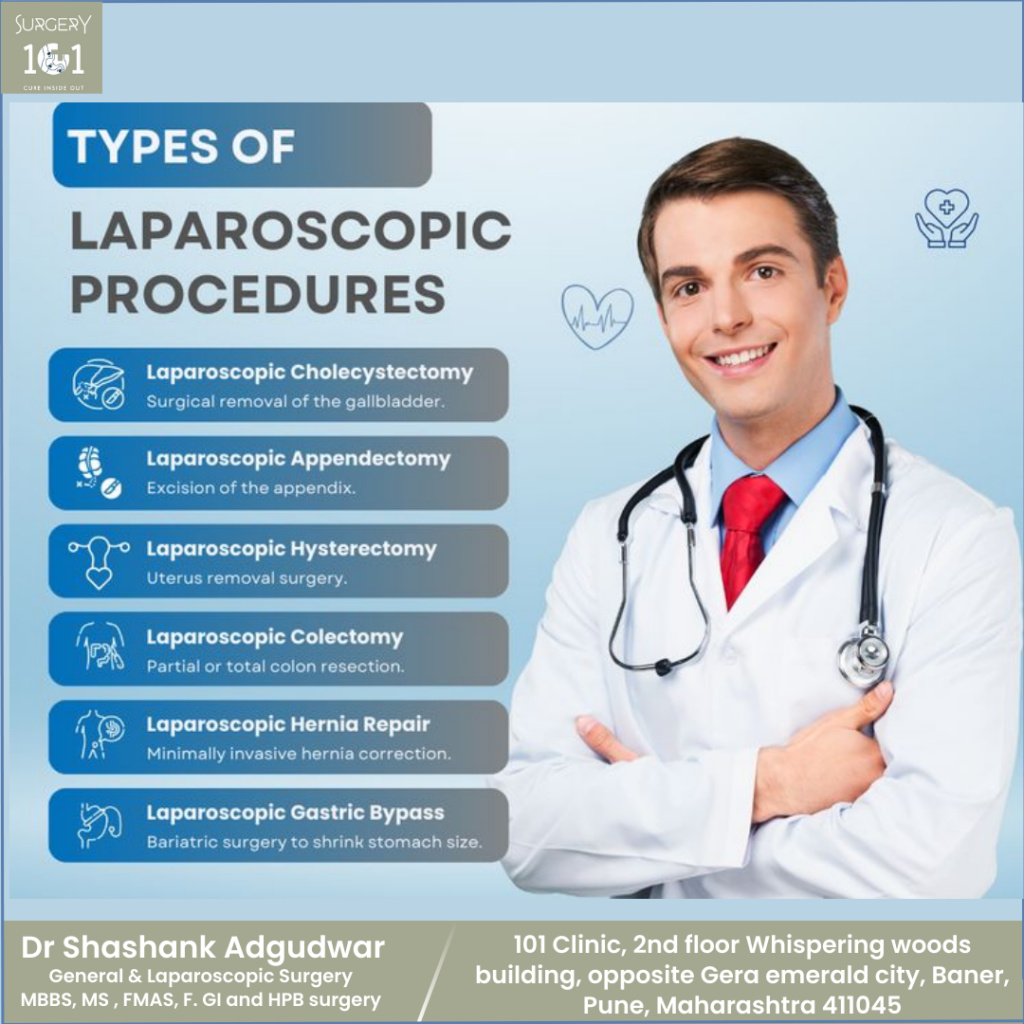In recent years, laparoscopic surgery has transformed the way surgeons approach many common and complex conditions. Often referred to as minimally invasive surgery or keyhole surgery, laparoscopic procedures use small incisions, a camera (laparoscope), and specialized instruments to perform surgeries with precision, safety, and faster recovery times.
Dr. Shashank Adgudwar, a trusted laparoscopic surgeon at The 101 Clinic, explains the common types of laparoscopic procedures and when they are used.
What is Laparoscopic Surgery?
Laparoscopic surgery involves making small cuts (typically 0.5-1 cm) instead of large incisions. Through these incisions, a laparoscope (a thin tube with a light and camera) and surgical tools are inserted to perform the surgery. The real-time visuals are displayed on a monitor, allowing the surgeon to operate with great accuracy.
Common Types of Laparoscopic Procedures
1. Laparoscopic Cholecystectomy (Gallbladder Removal)
One of the most common laparoscopic procedures, this surgery is performed to remove the gallbladder due to gallstones, infections, or gallbladder dysfunction. It is known for its shorter hospital stay and faster return to normal activities.
2. Laparoscopic Appendectomy (Appendix Removal)
Laparoscopic appendectomy is performed when a patient is diagnosed with appendicitis. Compared to open surgery, laparoscopic removal of the appendix results in smaller scars, less pain, and faster healing.
3. Laparoscopic Hernia Repair
This procedure is used to repair different types of hernias such as inguinal, umbilical, or ventral hernias. The surgeon uses a mesh to reinforce the weakened area, preventing recurrence.
4. Laparoscopic Hysterectomy (Uterus Removal)
In women requiring the removal of the uterus due to fibroids, abnormal bleeding, or cancer, laparoscopic hysterectomy offers a minimally invasive alternative with quicker recovery compared to traditional open surgery.
5. Laparoscopic Ovarian Cystectomy
Ovarian cysts that are large, painful, or suspicious are often removed laparoscopically. This helps preserve ovarian function while addressing the problem.
6. Laparoscopic Diagnostic Procedures
Sometimes, laparoscopy is used for diagnostic purposes, especially when imaging tests are inconclusive. It allows direct visualization of the abdominal and pelvic organs to diagnose conditions like endometriosis, pelvic inflammatory disease (PID), or unexplained infertility.
7. Laparoscopic Bariatric Surgery (Weight-Loss Surgery)
Bariatric surgeries like gastric bypass, sleeve gastrectomy, and adjustable gastric banding are often performed laparoscopically. They help patients with obesity lose weight safely and effectively.
8. Laparoscopic Colorectal Surgery
This is used for the treatment of colorectal cancers, diverticulitis, and other bowel conditions. It helps remove affected portions of the colon or rectum with less postoperative discomfort.
Book a Consultation with Dr. Shashank Adgudwar
Dr. Shashank Adgudwar is a skilled and experienced laparoscopic and general surgeon in Baner and Pune, offering patient-centered care with advanced laparoscopic techniques. Whether it’s gallbladder, hernia, or any abdominal issue, you can trust his expertise.

